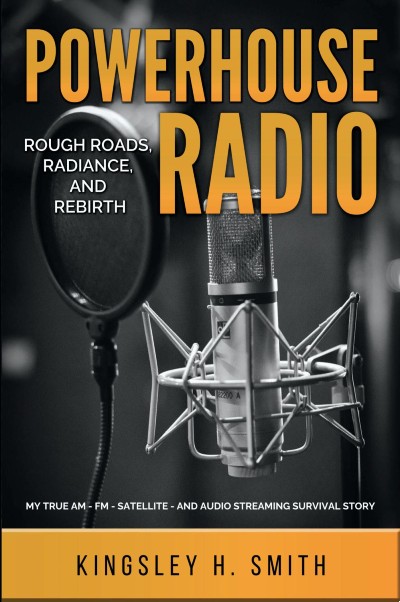Book Review: Powerhouse Radio: Rough Roads, Radiance, and Rebirth
by Kingsley H. Smith
Publication Date: Jan 10, 2024
List Price: $14.95
Format: Paperback, 180 pages
Classification: Nonfiction
ISBN13: 9798350912029
Imprint: BookBaby
Publisher: BookBaby
Parent Company: BookBaby
Read a Description of Powerhouse Radio: Rough Roads, Radiance, and Rebirth
Book Reviewed by Ahmad Wright
It is not often that a living person’s résumé reads as a memoir, however, Powerhouse Radio: Rough Roads, Radiance, and Rebirth written by Kingsley H. Smith includes a mix of historical industry milestones within the radio business and a front-seat perspective of the structure of radio station business models. Behind the on-air personality and the soundtracks of a particular music era, Smith introduces a framework of a business well beyond what a listener might fathom. Who knew that the playlists, promos, and news selections an audience enjoys were the result of a series of decisions supported by a technical and production crew the public will never know? That is, unless one of them literally writes their own book! Powerhouse Radio reveals these stories within Smith’s greater narrative of ascension, charting his rise from the bottom to the top!
Within his stated career trajectory among the hierarchy of radio station positions, starting from college radio at WNYU AM in the early 1970s to NPR, a span of more than four decades, one is reminded of radio’s early years when its reach was limited to a few territories per station. Smith’s job-hopping stories provide a preview to a bygone era of “limited listener options” where only a certain type of music was played in certain communities, usually not Black music. It is easy to see how Smith, in the late 1960s, as a young man—the boy who worked at Triboro Record Shop in Jamaica, Queens, New York—could latch on to such a broadening medium. The book lets the audience know one fact: He who learns the technology within a radio station and works their way up to affect the playlists, production, and on-air time frames for certain types of music, can impact the way a community experiences music, culture, and life.
In this journey, presented through Black radio and what Smith calls “general market rock radio,” we also get to see a few of the early behind-the-scenes game changers who took advantage of modifications in Federal Communications Commission (FCC) guidelines regarding discrimination. What we know today as Black radio is the result of hard-fought battles in the era of changing FCC guidelines: the 1978 Public Notice Statement of Policy on Minority Ownership of Broadcast Facilities that helped minorities get jobs in radio; the Atlantic Business & Community Development Corporation (ABCD) that helped to establish WUSS, the first Black-owned radio station in New Jersey; Roy Wood Sr., a host of the 1973 The National Black Network (NBN News), and a litany of allies who worked with Smith in some capacity to fight racism in the industry; organizations also helped to provide Black radio professionals a seat at the table; and a civil rights movement within the production booths and executive meeting rooms. Smith’s note of these historical segues help to jolt the memoir into a more substantial retelling, reminding the reader that Powerhouse Radio’s thrust as a personal story, and technical treatise, is also a front-row seat to a quiet revolution that a dedicated listener was rarely aware of unless it was announced in an era without blogs, social media, Facebook, X (formerly known as Twitter), or even cell phones.
Enter the pre-digital age, beyond the analogue radio station production technology introduced during the 1970s, and 1980s. Buried deep at the center of the book is a unique element of Smith’s tale, which should have been presented much earlier, his brainchild, an online Internet radio platform. During the age of dial-up, before streaming, before what we recognize today as social media, Smith’s many years of experience in radio, supported by a working interest in computers, culminate into a real presence in the Internet radio space, a new media version of what Smith seems to have been striving for all along—an innovative platform with a unique reach supported by his own curiosity, sweat equity, and industry savvy.
While the book is a bit clunky in terms of its organization, it has a heart. There are a lot of gems in the six-page preface where Smith provides his family background, and it feels like Powerhouse Radio is a kind of memoir with flashbacks of his memorable moments in the radio business. However, as the reader moves on, it is quite the reverse. There is a montage of Smith’s impact, his interpretation of the growth of Black radio, and his take on all things radio (including the blocked and italicized FCC rules). However, the biggest section of the book—the reason for the title—is hidden in the middle of the book, Powerhouse Radio and Smith’s foray into “tech” and Internet radio!
Powerhouse Radio is a manifesto with receipts; a slim volume of tales and accounts (facts are documented in a bibliography and with archival photographs), that offer a road map to success for anyone who has ever stuck to a childhood dream and made it a reality.

